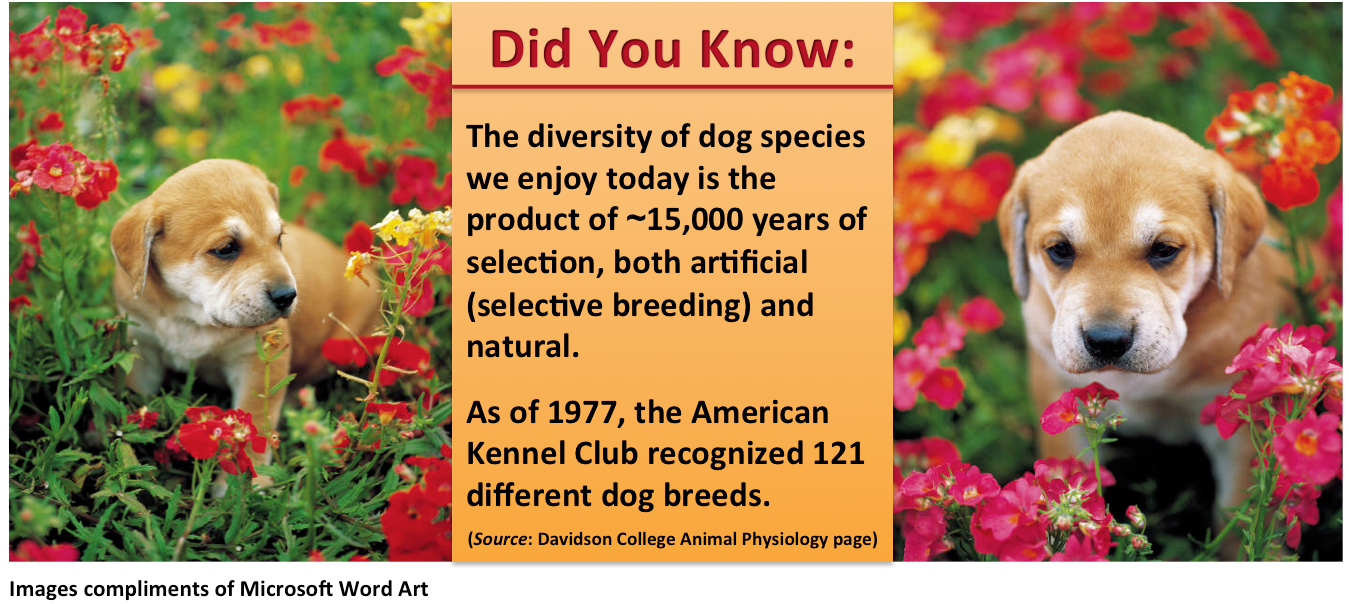![]()



This paper describes how Cadieu et al. (2009) uncovered three genes that contribute to the variety of coat types shared by today's domesticated dogs. The authors walk us through their methodology, findings, and implications, all of which weave together to tell a story worth fetching.
Background:
Both coat type and color are two common means of comparing different breeds of domesticated dogs. They also represent a diversity of phenotypes with largely undefined genetic underpinnings. While the latter method (color) had been previously well characterized, Cadieu et al. sought to localize genetic variations associated with different coat types. In specific, they searched for genes that contribute to three of the main coat phenotypes observed in today's dog breeds in the US:
Method:
Cadieu et al. used a variety of methods in order to locate genetic correlates for each of their chosen phenotypes. Firstly, they employed multiple Genome Wide Association Studies (GWAS), which utilize single-nucleotide polymorphisms (SNPs) to detect minute variations in the genome that may be associated with a specific phenotype (or disease) of interest. The three SNP data sets they used for GWAS included:
- 96 dachshunds with three coat varieties (see figure 1, panel A) used to address the furnishings phenotype (they also had another data set comprised of microsatellite markers from a 96-dachsund pedigree that they also used to map furnishings.)
- 76 Portuguese water dogs (PWDs) used to investigate the curl phenotype
- 903 dogs of 80 breeds and a plethora of phenotypes (called CanMap), which served as a means of ruling out incorrect associations as a result of population structure.
Cadieu et al. first compared the phenotype in question (growth pattern, length, or curl) by looking within one breed, segregating the dogs based on those with the phenotype (cases) and those without it (controls). They performed the within-breed GWAS to determine the locus most strongly associated with the phenotype. Next, the researchers confirmed the significance of this region by performing a GWAS using the CanMap data. The authors then further homed in on the variation by performing fine mapping, which involves comparing small sequences of wild type (lacking the phenotype) genetic information versus mutants (have the phenotype) to find the smallest haplotypes (chromosomal regions that tend to travel together) shared by the groups. Subsequent sequencing the identified region then revealed the specific genetic variation associated with their phenotypes of interest.
Findings: (also see Figure Summaries page)
(1) Growth Pattern - Furnishings (RSPO2)
As figure one demonstrates, Cadieu et al. localized a 167-base pair insertion within canine chromosome 13 (CFA13) that was associated with all the furnishing-bearing dogs they analyzed. More specifically, this insertion fell within the R-spondin-2 (RSPO2) gene, which the authors note is known to communicate with other proteins that promote hair follicle growth, including in the case of hair-follicle tumors. Furthermore, they found that the mutation lies within the 3’UTR, which often encodes factors that mediate translation (in specific, mRNA stability), and therefore conjectured if the insertion affected the protein's level of expression. Cadiueu et al. investigated this by taking muzzle skin biopsies to measure RSPO2 transcripts, for which they found a three-fold increase in those of dogs with furnishings… so cool! Additionally, they provided strong evidence that furnishings is a dominant trait, as 297 of 298 dogs with furnishings were either homo- or heterozygous for the insertion, while non of the dogs lacking furnishings contained the insertion... also, super cool!
(2) Hair Length - Long (FGF5)
Using the previously described mapping stategy, Cadieu et al. identified the gene FGF5 on canine chromosome 32 (CFA32) in dachshunds (see figure two, panel A). In specific, they located an animo acid change of Cysteine to Phenylalanine (Cys-->Phe) in exon 1 of FGF5. This finding agreed with the research of Housley et al. (2006), who located the same amino acid change in this highly conserved region of FGF5 in Welsh corgis with the long-haired (as opposed to "fluffy") phenotype.
Cadieu et al. then investigated the SNP most highly associated with the Cys-->Phe variation in other breeds with a variety of hair lengths. They had found that all of the long-haired dachshunds had a TT genotype for the SNP, while the other dachshunds (short or wire-haired) GG- or GT-containing alleles instead. Therefore, it is likely that FGF5-induced long hair is a recessive inheritance in these dogs. However, the researchers also found three charictaristically long-haired breeds (including the Afghan hound, a pup notorious for his lengthy locks) that do not have the Cys-->Phe alteration, and therefore FGF5 is probably not the sole gene influencing dogs' hair lengths.
(3) Hair Curl (KRT71)
Lastly, Cadieu et al. used the PWD data set for their GWAS of the curly coat phenotype, from which they located a SNP on canine chromosome 27 (CFA27). Additionally, the GWAS of their CanMap data set revealed another SNP closely associated with the curly phenotype in other breeds. When the researchers performed fine-mapping on the region, they found a haplotype that consisted of two keratin genes, one of which, KRT71, countainted the SNP with the highest association to curly coat. In particular, dogs that had curly coats had a TT genotype, whereas non-curly dogs were CC within the SNP. As it turns out, this SNP represents an Arginine to Tryptophan (Arg-->Trp) change in the keratin protein, which the authors conjecture may affect the cellular targeting, receptor beingins, or folding of the protein. In addition, they point to other studies that demonstrate KRT71 is influences curly hair in mice, thus providing additional support for their finding. Figure two, panels B and C address this curl locus.
Next: Figure Summaries
![]()
Email questions or comments to kaswart@davidson.edu
© Copyright 2011 Department of Biology, Davidson College, Davidson, NC 28035